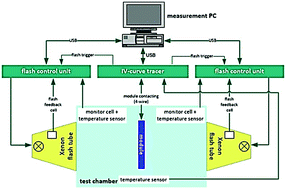当前位置:
X-MOL 学术
›
Energy Environ. Sci.
›
论文详情
Our official English website, www.x-mol.net, welcomes your feedback! (Note: you will need to create a separate account there.)
A review of crystalline silicon bifacial photovoltaic performance characterisation and simulation
Energy & Environmental Science ( IF 32.5 ) Pub Date : 2018-11-19 00:00:00 , DOI: 10.1039/c8ee02184h Tian Shen Liang 1, 2, 2, 3 , Mauro Pravettoni 1, 2 , Chris Deline 4, 5, 6 , Joshua S. Stein 6, 7, 8 , Radovan Kopecek 9, 10, 11 , Jai Prakash Singh 1, 2 , Wei Luo 1, 2 , Yan Wang 1, 2 , Armin G. Aberle 1, 2 , Yong Sheng Khoo 1, 2
Energy & Environmental Science ( IF 32.5 ) Pub Date : 2018-11-19 00:00:00 , DOI: 10.1039/c8ee02184h Tian Shen Liang 1, 2, 2, 3 , Mauro Pravettoni 1, 2 , Chris Deline 4, 5, 6 , Joshua S. Stein 6, 7, 8 , Radovan Kopecek 9, 10, 11 , Jai Prakash Singh 1, 2 , Wei Luo 1, 2 , Yan Wang 1, 2 , Armin G. Aberle 1, 2 , Yong Sheng Khoo 1, 2
Affiliation

|
Bifacial photovoltaic (PV) technology has received considerable attention in recent years due to the potential to achieve higher annual energy yield compared to its monofacial counterpart. Higher annual energy yield is a crucial factor (even more than to further reduce the module costs) because, with the use of higher power PV modules, the high BOS (Balance of System) costs can be reduced, resulting in the lowest LCOE (levelised cost of energy). The International Technology Roadmap for Photovoltaic (ITRPV) predicts an upward trend for the shares of crystalline silicon (c-Si) bifacial PV cells and modules in the global PV market in the next decade, i.e., more than 35% in 2028. Two key enabling factors have been identified to promote the widespread use of c-Si bifacial PV devices, namely the bifacial PV performance measurement method/standard for indoor characterisation and comprehensive simulation models for outdoor performance characterisation. Both will increase the bankability of bifacial PV technology. In this paper, a comprehensive review of the state-of-the-art of the c-Si bifacial PV performance characterisation and simulation is presented. First, an overview of the indoor characterisation of c-Si bifacial PV cells and modules is presented, followed by an overview of the outdoor characterisation of c-Si bifacial PV modules and the draft technical specification, IEC TS 60904-1-2. The second part of this paper reviews the current status of bifacial PV performance modelling, which includes the three primary sub-models: optical, electrical, and thermal models. This paper also provides an overview of the required future research to address the challenges associated with the characterisation and simulation of c-Si bifacial PV devices.
中文翻译:

晶体硅双面光伏性能表征与仿真研究进展
双面光伏(PV)技术近年来获得了相当大的关注,这是因为与单面光伏技术相比,它有可能实现更高的年发电量。较高的年能源产量是一个关键因素(甚至比进一步降低组件成本更重要),因为通过使用更高功率的光伏组件,可以降低高BOS(系统平衡)成本,从而实现最低的LCOE(均等化)。能源成本)。《国际光伏技术路线图》(ITRPV)预测,在未来十年中,晶体硅(c-Si)双面光伏电池和组件在全球光伏市场中的份额将呈上升趋势,即,到2028年将超过35%。已经确定了两个关键的促成因素,以促进c-Si双面光伏器件的广泛使用,即用于室内表征的双面PV性能测量方法/标准和用于室外性能表征的综合仿真模型。两者都将增加双面光伏技术的可融资性。本文对c-Si双面光伏性能表征和仿真技术进行了全面综述。首先,概述了c-Si双面PV电池和模块的室内特性,然后概述了c-Si双面PV模块的室外特性以及技术规范草案IEC TS 60904-1-2。本文的第二部分回顾了双面光伏性能建模的现状,其中包括三个主要子模型:光学模型,电气模型和热模型。本文还概述了需要进行的未来研究,以解决与c-Si双面光伏器件的表征和仿真相关的挑战。
更新日期:2018-11-19
中文翻译:

晶体硅双面光伏性能表征与仿真研究进展
双面光伏(PV)技术近年来获得了相当大的关注,这是因为与单面光伏技术相比,它有可能实现更高的年发电量。较高的年能源产量是一个关键因素(甚至比进一步降低组件成本更重要),因为通过使用更高功率的光伏组件,可以降低高BOS(系统平衡)成本,从而实现最低的LCOE(均等化)。能源成本)。《国际光伏技术路线图》(ITRPV)预测,在未来十年中,晶体硅(c-Si)双面光伏电池和组件在全球光伏市场中的份额将呈上升趋势,即,到2028年将超过35%。已经确定了两个关键的促成因素,以促进c-Si双面光伏器件的广泛使用,即用于室内表征的双面PV性能测量方法/标准和用于室外性能表征的综合仿真模型。两者都将增加双面光伏技术的可融资性。本文对c-Si双面光伏性能表征和仿真技术进行了全面综述。首先,概述了c-Si双面PV电池和模块的室内特性,然后概述了c-Si双面PV模块的室外特性以及技术规范草案IEC TS 60904-1-2。本文的第二部分回顾了双面光伏性能建模的现状,其中包括三个主要子模型:光学模型,电气模型和热模型。本文还概述了需要进行的未来研究,以解决与c-Si双面光伏器件的表征和仿真相关的挑战。



























 京公网安备 11010802027423号
京公网安备 11010802027423号